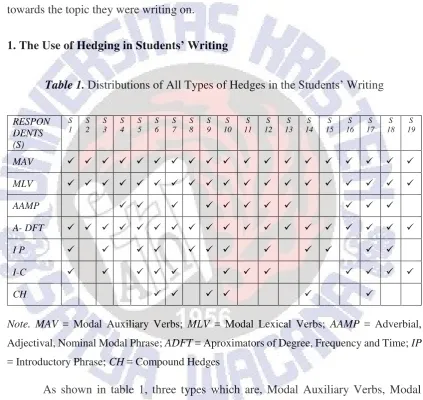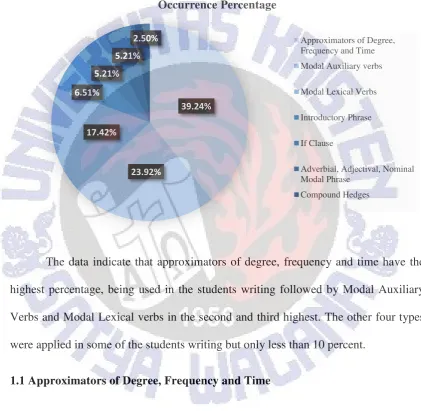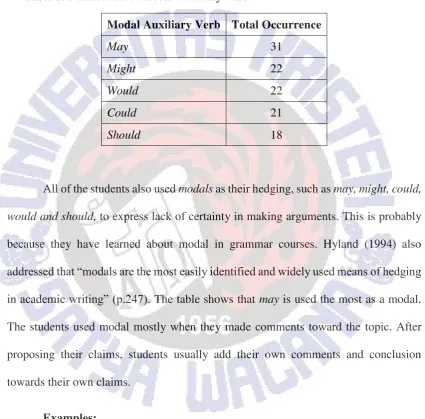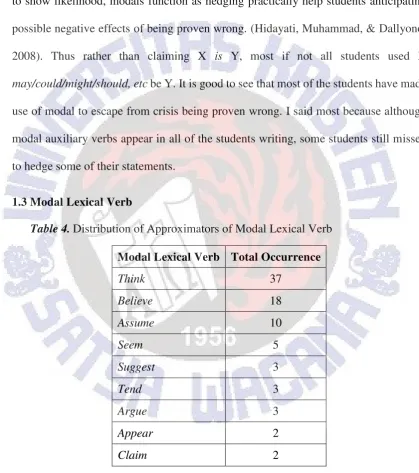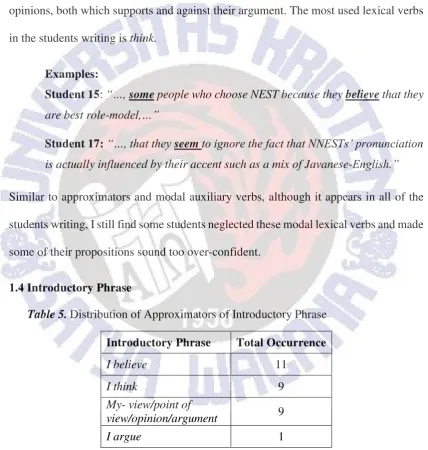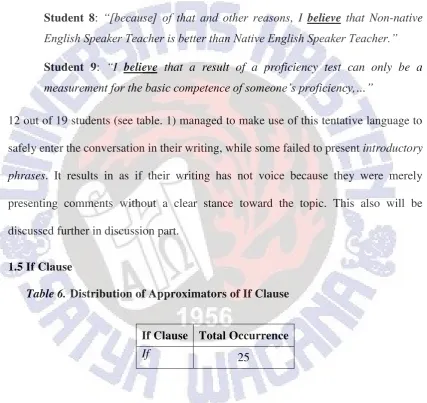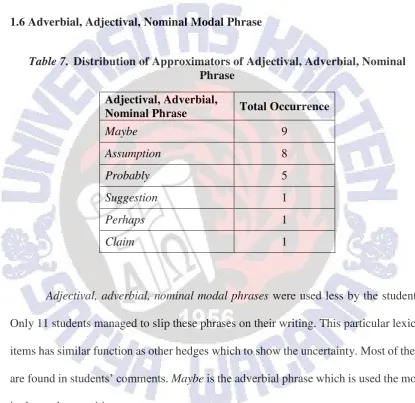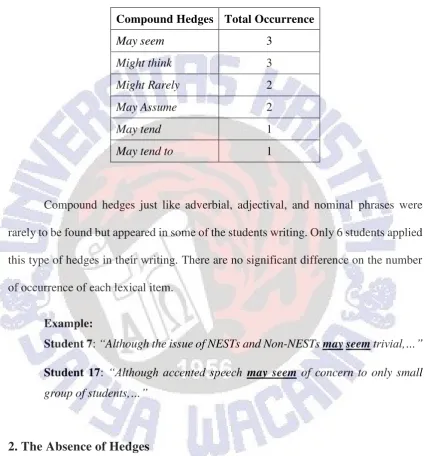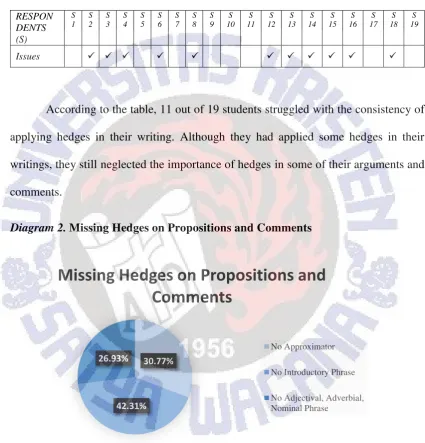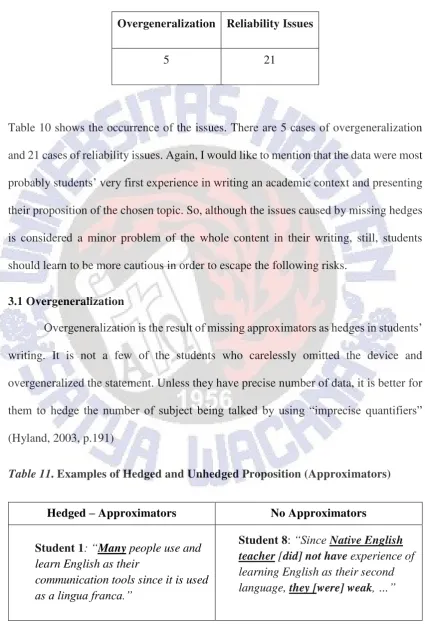THE USE OF HEDGING IN EFL ACADEMIC WRITING
THESIS
Submitted in Partial Fulfillment
of the Requirements for the Degree of
Sarjana Pendidikan
Alberta Marielka
112011042
ENGLISH DEPARTMENT
FACULTY OF LANGUAGE AND LITERATURE
SATYA WACANA CHRISTIAN UNIVERSITY
ii
THE USE OF HEDGING IN EFL ACADEMIC WRITING
THESIS
Submitted in Partial Fulfillment
of the Requirements for the Degree of
Sarjana Pendidikan
Alberta Marielka
112011042
ENGLISH DEPARTMENT
FACULTY OF LANGUAGE AND LITERATURE
SATYA WACANA CHRISTIAN UNIVERSITY
vi
COPYRIGHT STATEMENT
This thesis contains no such material as has been submitted for examination in any
course or accepted for the fulfillment of any degree or diploma in any university. To
the best of my knowledge and my belief, this contains no material previously published
or written by any other person except where due reference is made in the text.
Copyright@ 2015. Alberta Marielka.
All rights reserved. No part of this thesis may be reproduced by any means without
permission of at least one of the copyright of the English Department, Faculty of
Language and Literature, Satya Wacana Christian University, Salatiga.
viii
TABLE OF CONTENT
………..………
ii
COPYRIGHT STATEMENT
…...………...
vi
LIST OF TABLES ………..
x
Abstract ………...……….
1
INTRODUCTION………
1
1. Literature Review ………...
4
1.1 Hedges as an Element of Voice ………
4
1.2 Hedges in Academic Writing ……….………..
5
1.3 Taxonomy of Hedges ………...
6
THE STUDY ………..
9
1. Context of the Study
………...
9
2. Participants ………..
9
3.
Data Collection ………
9
4. Data Analysis ………..
10
DISCUSSION ………..
10
1. The Use of Hedging in Students’ Writing ………
11
1.1 Approximators of Degree, Frequency and Time ………
12
1.2
Modal Auxiliary Verb ………
14
1.3 Modal Lexical Verb ………..
15
1.4 Introductory Phrase ………
16
1.5 If Clause ………
17
ix
1.7 Compound Hedg
es ………
19
2. The Absence of Hedging
……….
19
2.1 No Approximators ……….………
21
2.2 No Introductory Phrase ………..
21
2.3 No Adjectival, Adverbial, Nominal Modal Phrase ………
22
3. Implication of the
Missing of Hedges in Students’ Writing
………
22
3.1 Overgeneralization
………
23
3.2 Reliability Issues or Hasty Assumption and Failed Implications 25
CONCLUSION ………..
27
Acknowledgment ………
29
REF
ERENCES ………
30
x
LIST OF TABLES
Table 1. Distributions of All Types of Hedges in the Students’ Writing
………….
11
Table 2. Distribution of Approximators of Degree, Frequency and Time
…………
12
Table 3. Distribution of Modal Auxiliary Verb
………
14
Table 4. Distribution of Approximators of Modal Lexical Verb
………..
15
Table 5. Distribution of Approximators of Introductory Phrase
………...
16
Table 6. Distribution of Approximators of If Clause
………..
17
Table 7. Distribution of Approximators of Adjectival, Adverbial, Nominal Phrase 18
Table 8. Distribution of Approximators of Compound Hedges
………..
19
Table 9. Occurrence of Issues in the Students’ Writing
………..
20
Table 10. Occurrence of Issues in the Students’ Writing
……….
20
Table 11. Examples of Hedged and Unhedged Proposition
(Approximators) …….
23
Table 12. Examples of Hedged and Unhedged Proposition (Adjectival, Adverbial,
Nominal Modal Phrase) ………
24
1
The Use of Hedging in EFL Academic Writing
Alberta Marielka
Satya Wacana Christian University
Abstract
Academic writing can be a mean of practice for EFL students in making
research paper to contribute in the development of their field of study. Hyland
(1994) proposed that that academic writing is rich in hedged proposition. He
also proposed that L2 learners are most likely to have problems with hedging.
This study was aimed to describe the distribution of use of hedges in EFL
students’ writing.
It was also aimed to see if students have been able to use
hedging appropriately. 19 first-drafts of EFL
students’ academic writing were
analyzed and classified based on its use of hedging. The results indicate that
the EFL students were able to applied at least 4 types of hedges based on
Salager-
Mayer’s taxonomy of hedges (1997)
in their academic writing.
However, more than a half of the subjects appeared to have problem in
applying hedges into their propositions and claims. It results in two main
issues. The implication of the study is regarding the introduction of hedges in
other courses other than academic writing. Being exposed to hedges in other
courses may help students comprehend hedges better.
Keywords:
hedges; academic writing; EFL; proposition; lexical items.
INTRODUCTION
2
practice in making a research paper.
“
Academic writing is believed to be cognitively
complex. Acquisition of academic vocabulary and discourse style is particularly
difficult”
(Myles, 2002, para.8). Newfields (2003) believes
that students’ ability to
write clearly about topics related to their research fields is essential and is regarded as
one of the authentications of a higher education. More importantly because they are
scholars who are expected to produce numbers of writing for the development of the
field of study they are in, after they graduate. In the course the students are introduced
to techniques such as quoting, summarizing, paraphrasing, and hedging. This study
focused on analyzing the use of hedges on the
students’ academic writing
. As Hedges
function as one of the elements of voice construction, and according to Steward (as
cited in Zhao, 2012) voice
“
is believed to be the fundamental of good writing
”
(p.202).
Hedges are now recognized as important devices in writing as many scholars are
interested in making study about this particular tools. Myers (as cited in Salager-Meyer,
1997) considers hedges as positive or negative politeness strategies. Hedges are
believed as one of devices to modify writers’ assertions, specifically to tone down
3
However, studies about hedges are of course not merely discussing about its
function. There are some issues regarding the application and the understanding of
hedges, especially in L2 learners
’
writing. According to
Hidayati, Muhammad, &
Dallyono (2008) and Hyland (1996) it is difficult for foreign students even the formally
proficient L2 writers to adequately hedge their propositions. Dalyono and his fellows
found that the S-1 graduates, their subjects of study, seem to have lack understanding
of concept of hedging as they failed to give specific explanation to their hedged
features. While Hyland (1996) found that the number of hedges used in L2 corpora are
far a lesser amount compared to the native students
’
corpora. Not only having problems
in presenting hedges in their writing, recognizing hedges on a text also could be
problematic to L2 learners. Hyland (2000) found
that “the efforts of academic writers
to weaken their commitment and withhold certainty from their propositions may go
unnoticed by L2 readers
.”
He indicates that that modal such as
may
and
might
“tended
to be accorded greater assurance
than they usually receive”
by L2 learners (pp.19-20).
These studies shows that L2 learners have difficulties comprehending hedges whether
it’s within their own writing or in others.
Thus, the significance of this study is too see
if the students, who have been studying English in the Faculty for at least 2,5 years, had
used hedging effectively.
4
1. Literature Review
The following sections discuss about
hedges as an element of voices
,
hedges in
academic writing
and also
the taxonomy of hedges
which is used as the framework in
this study.
1.1
Hedges as an Element of Voice
To see whether or not students have successfully become good writers is by
seeing how they convey their ideas or claims. Writing gives writer the opportunity to
look for sources before they state their claims on writing and how they deliver it through
sentences is what we called voice. According to Hyland (2008) (as cited in Zhao, 2012)
voice is essentially an interaction between writers and readers. Hyland also states that
“writing can’t
not have a voice. Voice, then, is not an optional extra but an aspect of
how we position ourselves in relat
ion to our communities”.
However to be able to see voice on a writing, according to Zhao (2012), there
are two major systems of interactional model of voice which are writer-oriented and
reader-oriented. Reader-oriented engagement
“
is realized through
readers pronouns,
personal asides, references to shared knowledge, directives and (rhetorical/audience
directed) questions.
”
Whereas writer-oriented refers
“
to how writers present
themselves, their opinions and their arguments through the use of four linguistically
available elements:
hedges, boosters, attitude markers and authorial self-mention
”
(p.203).
5
attitudes play “
an essential role in building the argumentative structure of the scientific
article, and in conveying the nuances that
help to support the author’s knowledge
claims
.”(
p.248)
1.2
Hedges in Academic Writing
“As the academic world is that of “uncertainties, indirectness, and non
-
finality”
(Mauranen 1997: 115), it is hardly surprising that hedges play a major role in academic
discourse
”
(Riekkinen, 2009, pp.10). In most academic papers, author most likely
borrows other authors’ ideas to help them support their claims. However, when they are
6
the text as well as the persuasiveness of the ideas” (Šeškauskien
, 2008). It also relates
to what Gillet, Hammond, & Martala (2009) state
in their book, ‘
Inside Track to
Successful Academic Writing’
that “
academic writing often calls for a cautious style,
and there are various ways in which caution can be expressed” (p.206).
Showing
caution according to them, can be done through the use of hedges.
1.3
Taxonomy of Hedges
Hedges was first introduced by George Lakoff (1973, p.471), who defined
h
edges as “
words whose job is to mak
e things fuzzier or less fuzzy”
. Following his
research, many scholars have attempted to explore and ascertain more about the
application of hedges.
They developed Lakoff’s idea based on their understanding. This
what pro
bably leads Crompton (1997) to premise that hedging cannot “be pinned down
and labelled as a closed set of lexical items” because “to count all uses of certain
linguistic tokens as hedges is to run the risk of misinterpreting the discourse” (pp.279
-281). Thus, until this present time there are no fixed types or model of classification of
hedges and the following models and some other models from other scholars can be
considered as references to understand hedging better. Hyland (1994), the most known
scholar in study of Hedging classified the following lexical items, as hedges:
(1) Modal
auxiliary verbs;(2) Adjectival, adverbial and nominal modal of expression; (3) Modal
lexical verbs; (4) If clauses; (5) question forms; (5) Passivisation; (6) Impersonal
phrases and (7) Time reference.
7
Approximators
Adaptors
sort of, kind of somewhat, really, almost,
quiet, entirely, a little bit, to some extent,
more or less
Rounders
Approximately,
essentially,
about,
something between..and.., roughly
Shields
Plausibility Shields
Think, guess, believe, afraid, assume,
suppose
, seem, as far as I’m concerned
Attribution Shields
someone suggests that ; it is reported that
Approximators refers to “expressions which call change to the original meaning”.
They
“express the degree of correctness”
.
Rounders
“indicates t
he inexact preciseness of
terms
”
(p.563). Another one, shields
“
indicates that speakers are not fully committed
to the validity of the
proposition they are conveying”
(p.563).
Plausibility shields
shows
“speakers’ own attitude towards a
proposition.
”
Attribution Shields
shows “the
degree of uncertainty towards
a proposition to another party”
(Hua, 2011, pp 563 -564)
8
other. Thus, I decided to use Salager-Meyer (1997) taxonomy of hedges, which seems
to meet both previous scholars’
understanding of hedges. This taxonomy also represents
“the most widely used hedging category” (p.109).
Modal Auxiliary verbs -
MAV
may, might, could, would, should
Modal Lexical Verbs -
MLV
to seem, to appear, to believe, to
assume, to suggest, to estimate, to tend,
to think, to argue, to indicate, to
propose, to speculate
Adjectival, Adverbial, Nominal modal
phrases
–
A,A,N -MP
Adjective: possible, probable, un/likely.
Nouns: assumption, claim, possibility,
estimate, suggestion
Adverbs: perhaps, possibly, probably,
practically, likely, presumably,
virtually, apparently.
Approximators of Degree, quantity,
frequency and time -
A-DQFT
Approximately, roughly, about, often,
occasionally, generally, usually,
somewhat, somehow, a lot of.
Introductory Phrases -
IP
Believe, to our knowledge, it is our
view that, we feel that
If clauses -
IC
If true, if anything
9
THE STUDY
1.
Context of the Study
This study is carried out in Faculty of Language and Literature, Satya Wacana
Christian University, Salatiga, Indonesia. It has two programs which are English
Education and English Literature. The subjects of the study are students majoring
in English Education. The ease of the researcher to reach the sites were the reason
behind this selection. The students being the subjects are also Non-Native Speaker
of English whose mother tongue are not English thus they suit the researcher target
subjects which are L2 learners of English.
2.
Participants
The researcher used convenience sampling and took 19 first drafts from one out
of 4 classes opened in the even semester of 2014/2015. The participants of the study
are 19 students majoring in English of Education. They have enrolled in the Faculty
for at least 2,5 years and were taking academic writing course of 4-credit hour
during the semester. All of the students have passed the 3 pre-requisite writing
classes;
Guided Writing, Narrative and Descriptive Writing
and
Expository and
Argumentative Writing.
3.
Data Collection
10
course, students could choose one out of two topics which were
‘
Native and
Non-Native English Speaker Teacher
in English Language Teaching’
and about
‘
Proficiency Test
as a Marker of Students’ Competence’
. They were already
provided several articles and journals with similar topic to then make use of them
as supports. Secondly, the students constructed the writing in class and had a chance
finishing it at home. Hedges were covered only one session throughout the semester
and students acknowledge hedges as a tool to show uncertainty in general. These
were done according to the
course’s
syllabus. Researcher then collected the data
which are the students’ first drafts
from the lecturer.
4.
Data analysis
Researcher analyzed the use of hedges in students writing and classified it
according to the taxonomy of hedging proposed by Salager-Meyer (1997) since
according to him, it represents
“
the most widely used hedging category
”
(p.109).
Moreover, it covers the other two known taxonomies proposed by Hyland (1994)
and Prince (1982). The researcher read the whole essay of each students and sorted
out sentences
in the students’
writing. The researcher classified sentences with
hedges accordingly and proposition and comments which need hedging accordingly
Researcher then analyzed the data to describe the type of hedges used by students
and the problems which occur in the application of hedging.
DISCUSSION
11
and claims to later be supported by examples, explanations or previous research in order
to strengthen their propositions or claims.
Proposition refers to “sentence or expression
that is either true or
false”(Neuffer, n.d, para.1)
. The following are discussion on the
distribution of hedging in
the EFL students’
propositions or claims and comments
towards the topic they were writing on.
1. The Use of Hedging in Students
’ W
riting
Table 1. Distributions of All Types of Hedges in the S
tudents’
Writing
RESPON DENTS (S) S 1 S 2 S 3 S 4 S 5 S 6 S 7 S 8 S 9 S 10 S 11 S 12 S 13 S 14 S 15 S 16 S 17 S 18 S 19
MAV
MLV
AAMP
A- DFT
I P
I-C
CH
Note. MAV = Modal Auxiliary Verbs; MLV = Modal Lexical Verbs; AAMP = Adverbial,
Adjectival, Nominal Modal Phrase; ADFT = Aproximators of Degree, Frequency and Time; IP
= Introductory Phrase; CH = Compound Hedges
As shown in table 1, three types which are, Modal Auxiliary Verbs, Modal
Lexical Verbs and Approximators appeared in all of the students’ writing. The
12
The following section discussed further about the use of each type in the students
writing.
Diagram 1. Occurrence Percentage
The data indicate that approximators of degree, frequency and time have the
highest percentage, being used in the students writing followed by Modal Auxiliary
Verbs and Modal Lexical verbs in the second and third highest. The other four types
were applied in some of the students writing but only less than 10 percent.
1.1
Approximators of Degree, Frequency and Time
Table 2. Distribution of Approximators of Degree, Frequency and Time
Approximators of
Degree, Time and
Frequency
Total
Occurrence
Many
82
Some
80
Most
14
39.24%
23.92% 17.42%
6.51% 5.21%
5.21% 2.50%
Occurrence Percentage
Approximators of Degree, Frequency and Time
Modal Auxiliary verbs
Modal Lexical Verbs
Introductory Phrase
If Clause
Adverbial, Adjectival, Nominal Modal Phrase
13
Usually
8
Often
2
Somehow
1
Majority
1
Approximators
used in the
students’ writing were
mostly used by the students to
show that they were not sure with the precision of the data they have. The table shows
that most used approximators are
many
and
some
. Approximators function to show that
the “proposition is correct or it is partially correct” (Hua, 2011, p. 563).
I found most
of the
approximators
in the introduction of the writing when they were trying to bring
out the issue by stating people’s opinion and or thoughts.
Examples:
Student 1
: “
Many
people use and learn English as their communication tools
since it is used as a lingua franca.”
Student 9: “
Nowadays,
many
people around the world, especially academic
communities,
…”
Graff & Birkenstein suggested that to enter a conversation students can use what
others say “or might say” as a launching pad or sounding board for their ideas (2006).
14
and time
were also found, such as
often, usually and somehow
but not as many as
approximators of quantity
.
1.2
Modal Auxiliary Verb
Table 3. Distribution of Modal Auxiliary Verb
Modal Auxiliary Verb Total Occurrence
May
31
Might
22
Would
22
Could
21
Should
18
All of the students also used
modals
as their hedging, such as
may,
might, could,
would and should,
to express lack of certainty in making arguments. This is probably
because they have learned about modal in grammar courses. Hyland (1994) also
addressed that “modals are the most easily identified and widely used means of hedging
in academic writing” (p.247).
The table shows that
may
is used the most as a modal.
The students used modal mostly when they made comments toward the topic. After
proposing their claims, students usually add their own comments and conclusion
towards their own claims.
Examples:
Student 1:
“I
t
might be
the reason why some people underestimate non-native
teachers over native teachers, …”
15
According to Lock (1996) these modals
function as the “speaker’s judgment of the
likelihood of the information in the clauses being true”
(p.194). It also range from the
high, mid to low level of certainty they express (Lock, 1996).
Aside from its’ function
to show likelihood, modals function as hedging practically help students anticipating
possible negative effects of being proven wrong. (Hidayati, Muhammad, & Dallyono,
2008). Thus rather than claiming X
is
Y, most if not all students used X
may/could/might/should, etc
be Y. It is good to see that most of the students have made
use of modal to escape from crisis being proven wrong. I said most because although
modal auxiliary verbs appear in all of the students writing, some students still missed
to hedge some of their statements.
1.3
Modal Lexical Verb
Table 4. Distribution of Approximators of Modal Lexical Verb
Modal Lexical Verb Total Occurrence
Think
37
Believe
18
Assume
10
Seem
5
Suggest
3
Tend
3
Argue
3
Appear
2
Claim
2
16
Advanced Learners’ Dictionary (2007, p
.1582)
defines tentative as “not definite or
certain because you may want to change it later”
. The modal lexical verbs in the
students writing are including words such as
believe, think, assume, seem, appear,
suggest, tend, argue, and claim
. Students used this lexical items
to introduce others’
opinions, both which supports and against their argument. The most used lexical verbs
in the students writing is
think
.
Examples:
Student 15:
“…,
some
people who choose NEST because they
believe
that they
are best role-
model,…”
Student 17:
“…, that they
seem
to ignore the fact that NNESTs’ pronunciation
is actually influenced by their accent such as a mix of Javanese-
English.”
Similar to approximators and modal auxiliary verbs, although it appears in all of the
students writing, I still find some students neglected these modal lexical verbs and made
some of their propositions sound too over-confident.
1.4
Introductory Phrase
Table 5. Distribution of Approximators of Introductory Phrase
Introductory Phrase
Total Occurrence
I believe
11
I think
9
My- view/point of
view/opinion/argument
9
I argue
1
17
their statement is
not absolutely right or true since it is just their own opinions” (Hua,
2011, p.563). They were mostly used to introduce a claim on a new passage. Modal
lexical ‘believe’ is used most by the students as an introductory phrase.
Examples:
Student 8:
“[because] of that and other reasons
, I
believe
that Non-native
English Speaker Teacher is better than Native English Speaker Teacher.”
Student 9:
“
I
believe
that a result of a proficiency test can only be a
measurement for the basic competence of someone’s proficiency,…”
12 out of 19 students (see table. 1) managed to make use of this tentative language to
safely enter the conversation in their writing, while some failed to present
introductory
phrases
. It results in as if their writing has not voice because they were merely
presenting comments without a clear stance toward the topic. This also will be
discussed further in discussion part.
1.5
If Clause
Table 6.
Distribution of Approximators of If Clause
If Clause Total Occurrence
If
25
If- clauses
were also found
in the students’ writing
. 12 students applied this on
their writing. They made use of if when trying to explain their proposition. In order to
make an example or illustration of a case before giving arguments.
18
Student 6:
“
For example,
if
the student did not understand what the teacher
said, they can ask the teacher to repeat,…”
Student 7:
“
If
some
people including researchers
think
that NESTs are not
really good in teaching English, here I will,…”
1.6
Adverbial, Adjectival, Nominal Modal Phrase
Table 7
.
Distribution of Approximators of Adjectival, Adverbial, Nominal
Phrase
Adjectival, Adverbial,
Nominal Phrase
Total Occurrence
Maybe
9
Assumption
8
Probably
5
Suggestion
1
Perhaps
1
Claim
1
Adjectival, adverbial, nominal modal phrases
were used less by the students.
Only 11 students managed to slip these phrases on their writing. This particular lexical
items has similar function as other hedges which to show the uncertainty. Most of them
are found in st
udents’ comments.
Maybe
is the adverbial phrase which is used the most
in the students writing.
Example:
Student 15
:
“
despite the fact that
maybe
some NNEST who take a study
abroad,…”
19
1.7
Compound Hedges
Table 8.
Distribution of Approximators of Compound Hedges
Compound Hedges Total Occurrence
May seem
3
Might think
3
Might Rarely
2
May Assume
2
May tend
1
May tend to
1
Compound hedges just like adverbial, adjectival, and nominal phrases were
rarely to be found but appeared in some of the students writing. Only 6 students applied
this type of hedges in their writing. There are no significant difference on the number
of occurrence of each lexical item.
Example:
Student 7:
“
Although the issue of NESTs and Non-NESTs
may
seem
trivial,…”
Student 17
:
“Although accented speech
may
seem
of concern to only small
group of students
,…”
2. The Absence of Hedges
20
have acquired the skill of using hedges within their writing, they still have to pay
attention in the consistency of applying hedges.
Table 9.
Occurrence of missing hedges
in the Students’ Writing
RESPON DENTS (S) S 1 S 2 S 3 S 4 S 5 S 6 S 7 S 8 S 9 S 10 S 11 S 12 S 13 S 14 S 15 S 16 S 17 S 18 S 19Issues
According to the table, 11 out of 19 students struggled with the consistency of
applying hedges in their writing. Although they had applied some hedges in their
writings, they still neglected the importance of hedges in some of their arguments and
comments.
Diagram 2.
Missing Hedges on Propositions and Comments
The diagram shows the distribution of missing hedges. I found 26 problematic
sentences. The problematic sentences refers to sentences without hedges. However the
three main missing hedges in the students writing are approximators, introductory
phrase and adjectival, adverbial and nominal verbs. Adjectival, adverbial and nominal
30.77%
42.31% 26.93%
Missing Hedges on Propositions and
Comments
No Approximator
No Introductory Phrase
21
verbs could actually be replaced by compound hedges and modal auxiliary verbs while
introductory phrase could also be replaced by modal lexical verb. The application of
the hedges depends on the style of writing of the author. Thus, I narrowed down the
missing hedged into the three lexical items only according to what hedges I believe
should suit the statement best. The three lexeme, I believe have the most significance
in the strength of the st
udents’ propositions.
2.1 No Approximators
Although approximators are the most used hedges in the students writing. Some
students forgot to apply one in some of their propositions. 8 out of 26 problematic
sentences or 30.77% of the problematic sentences are those without approximators.
Example:
Student 8:
“Since
Native English teacher
[
did] not have
experience of learning
English as their second language,
they [were] weak
, …”
Student 13:
“
It is not only English native speakers do that, but
every
native
speakers of their mother tongue [do]
that.”
2.2 No Introductory Phrases
Introductory phrases is considered important because by applying them on the
propositions helps readers recognize that it was the students’ idea or own words.
Modal
lexical verbs such as believe, assume, or argues which usually collocate to the pronouns
used by the students. It also helps readers recognize the certainty of their statements.
However, some students are still missing this particular lexical item functions as
hedging device on their statements. 11 sentences or about 42.30% of the problematic
sentences are found without introductory phrases.
22
Student 3:
“While NESTs not really pay attention in grammar, NNESTs give more
detail in correcting the grammar.”
Student 8:
“NNESTs are better in reading and speaking skills, and also grammar
because they learn it, unlike NESTs who get it unconsciously.”
2.3 No Adjectival, Adverbial, Nominal Modal Phrase
Another missing hedges are adjectival, adverbial, nominal modal phrase. About
26.92% or 7 out of 26 sentences are found without this particular hedges. The students
seems to have limited vocabulary register relating to adjectival, adverbial, nominal
modal phrase seeing that this particular lexical items were used less and when it could
actually be inserted in their statements.
Example:
Student 2:
They have already read the book related to the material discussion in
every meeting.
Student 4:
Beside non-native English speaker teachers have more knowledge in
teaching English as foreign language; they also always do better preparation in
teaching English in classroom.
3. Implication of the Missing of Hedges in Students
’
Writing
23
Table 10.
Occurrence of Issues in the Students’ Writing
Overgeneralization Reliability Issues
5
21
Table 10 shows the occurrence of the issues. There are 5 cases of overgeneralization
and 21 cases of reliability issues. Again, I would like to mention that the data were most
probably st
udents’ very first experience in writing
an academic context and presenting
their proposition of the chosen topic. So, although the issues caused by missing hedges
is considered a minor problem of the whole content in their writing, still, students
should learn to be more cautious in order to escape the following risks.
3.1 Overgeneralization
Overgeneralization is the result of missing approximators as hedges in students’
writing. It is not a few of the students who carelessly omitted the device and
overgeneralized the statement. Unless they have precise number of data, it is better for
them to hedge the number of subject being talked by using “imprecise quantifiers”
(Hyland, 2003, p.191)
Table 11. Examples of Hedged and Unhedged Proposition (Approximators)
Hedged
–
Approximators
No Approximators
Student 1
: “
Many
people use and
learn English as their
communication tools since it is used
as a lingua franca.”
24
Student 9
: “
Nowadays,
many
people around the world, especially
academic communities, …”
Student 13:
“It is not only English
native speakers do that, but
every
native speakers of their mother
tongue [do] that.”
Not only
approximators
, the inexistence of hedges such a
s the adverbial, adjectival,
nominal modal phrase
can actually also results in overgeneralization.
The two
examples shows that the students overgeneralized NEST by not using any hedges. It
probably best for them to add hedges such as
perhaps
or
probably
so that the reader
would not attack them for being so confident with their statements. This relates to the
function of hedges as an anticipation of possible negative consequences being proved
wrong.
[image:35.595.97.530.204.757.2]“
Academics seek agreement for the strongest claims they can for their evidence, as
this is how they gain their academic credibility, but they also need to cover
themselves against the embarrassment of categorical commitment to statements that
later may be shown to be wildly inaccurate.
” (Hyland, 1996, p.479)
Table 12. Examples of Hedged and Unhedged Proposition (Adjectival, Adverbial,
Nominal Modal Phrase)
Hedged
–
Adjectival, Adverbial,
Nominal Modal Phrase
No Adjectival, Adverbial, Nominal
Modal Phrase
Student 15
:
“
despite the fact that
maybe
some NNEST who take a study
abroad,…”
Student 2:
They have already read
the book related to the material
discussion in every meeting.
Student 16
: “
it did not mean that his
NEST did not know the answer, but
perhaps
his NEST could not explain it”
25
do better preparation in teaching
English in classroom.
3.2 Reliability Issues or Hasty Assumption and Failed Implications
[image:36.595.99.528.195.621.2]The sentences which I sorted in reliability issues are those without supports from
any previous studies and without introductory phrases. As scholars they have to be clear
about the idea they are proposing, whether it is theirs’ or others’. Thus, it is necessa
ry
to add introductory phrases to show that it was their arguments toward the topic.
Table 13. Examples of Hedged and Unhedged Proposition (Introductory Phrases)
Hedged
–
Introductory Phrases
No Introductory Phrases
Student 8:
“[because] of that and
other reasons, I
believe
that
Non-native English Speaker Teacher is
better than Native English Speaker
Teacher.”
Student 3:
“While NESTs not really
pay attention in grammar, NNESTs
give more detail in correcting the
grammar.”
Student 9:
“
I
believe
that a result of a
proficiency test can only be a
measurement for the basic competence
of someone’s proficiency,…”
Student 8:
“NNESTs are better in
reading and speaking skills, and
also grammar because they learn it,
unlike NESTs who get it
unconsciously.”
26
and argue.
This may also relate to what Hyland (2000) presented in his one of his
empirical study
that “
the effort of academic writers to weaken their commitment and
withhold certainty from their propositions may go unnoticed by L2 readers” (p.19)
.
Example:
Student (3)
: Non-native English teachers
are great
in teaching grammar and
reading,… Mahboob’s (as cited in The Malaysian Online Journal of
Educational Science, 2010) study that is point out that the learners
assumed
the
NNESTs were great for educating reading, grammar and listening.
They have to be careful not only in formulating their writing but also in interpreting the
sources they are using in their writing.
Example:
Student 16
: “
Another reason why Non-NEST is better teacher than NEST is
they are well-trained. Many Non- NESTs have taken formal or informal class
before they teach English.”
Student 12:
“
As grammar is the most important in arranging sentences in
English, there are three course level of grammar that we need to take in my
faculty,…”
27
CONCLUSION
As the aim of this study is to describe the use of hedging in EFL students’
academic writing, in conclusion, the students have already been able to apply hedges in
their writing. All types of hedges proposed by Salager-Meyer (1997) are found in the
students writing showing that they are already exposed and aware of the existence of
hedging though the distributions are not even from each students.
Approximators
are
used the most by the EFL students followed by modal auxiliary verbs and modal lexical
verbs which appeared in all of the students writing. The other four types of hedges,
adjectival, adverbial, nominal modal phrase; if clause; introductory phrase and
compound hedges were also appeared in the EFL students writing but distribution are
not even.
Another finding in this study also indicates that more than 50% of the students
failed to apply hedges accordingly within their proposition and comments in their
academic writing. 11 out of 19 students failed to consistently apply hedges in their
propositions. This shows that what Hyland (2000) proposed about L2 learners having
difficulties in comprehending hedges is most probably true. The problem of missing
hedges in the students’ wr
iting also results in two main issues which are
overgeneralization and reliability issues.
28
are using. Once they understand better the function of particular lexical items as
hedging, I believe they would be able to understand an academic text better and write
a better academic paper as well as according to
Hidayati, Muhammad, & Dallyono
(2008) students need to recognized hedges in order to sharpen their writing.
As this finding is only based on the researcher’s interpretation of the data,
29
Acknowledgement
I wish to express my appreciation to individuals who guided and supported me until
completion of this Report Writing.
I would like to express my gratitude to Almighty Jesus Christ for the never-ending
blessing He has given me. I am also very grateful to my “super
-
inspirational” thesis
supervisor, Ibu Dr. Elisabet Titik Murtisari, M.TranStud., PhD. for kindly helping,
guiding, and intellectually nourishing me throughout the battle and for not quitting on
me despite of me being lazy. I would also like to show my appreciation to Ibu Debora
Tri Ragawanti, MA-ELT as my thesis examiner.
My deepest gratitude goes to my very own motivation, my beloved parents, Yuliana
Puji Suratmi and Haryono Daud for their unconditional love, supports, prayers, and
motivations throughout my life. Same goes to my beloved sisters and brother, Mba
Ayas, Mia, Leon, Caca and Sei for supporting and cheering on me in every way that
they can.
30
REFERENCES
Algi, S. (2012).
Hedges and Boosters in L1 and L2 argumentative Writing.
Crompton, P. (1997). Hedging in Academic Writing: Some Theoritical Problems.
English for Specific Purposes, 16
(4), 271-281.
Gillet, A., Hammond, A., & Martala, M. (2009).
Successful Academic Writing .
Harlow:
Pearson Education Limited.
Graff, G., & Birkenstein, C. (2006).
"They Say I Say" The Moves That Matters in
Academic Writing.
New York: W. W. Norton & Company.
Hidayati, F., Muhammad, A., & Dallyono, R. (2008). The Use of Hedging in Academic
Discourse.
Educationist, 2
(1), 27-37.
Hua, J. (2011). A Study on Pragmatic Functions of Hedges Applied by College English
Teachers in the Class.
M&D FORUM
, 562-566.
Hyland, K. (1994). Hedging in Academic Writing and EAP Textbooks.
English for
Specific Purpose, 13
(3), 239-256.
Hyland, K. (1995). The Author in the Text: Hedging Scientific Research.
Hongkong
Papers in Linguistic and Language Teaching
, 33-42.
Hyland, K. (1996). Nurturing Hedges in the ESP Curriculum.
System, 24
(4), 477-490.
Hyland, K. (1998). Boosting, Hedging and the Negotiation of Academic Knowledge.
TEXT,
18
(3),
349-382.
Retrieved
from
http://www2.caes.hku.hk/kenhyland/files/2012/08/Boosting-hedging-and-the-negotiation-of-academic-knowledge.pdf
Hyland, K. (2000). Hedges, Boosters and lexical invisibility: noticing modifiers in
academic texts.
Language Awareness, 9
(4), 179-197.
Hyland, K. (2003).
Second Language Writing.
(J. C. Richards, Ed.) New York:
Cambridge University Press.
Hyland, K., & Milton, J. (1997). Qualification and Certainty in Ll and L2 Students'
Writing.
Journal of Second Language Writing, 6
(2), 183-205.
Javid, C. Z., & Umer, M. (2014). Saudi EFL Learners' Writing Problems: A Move
Towars Solution.
Global Summit on Education GSE 2014
(pp. 164-180). Kuala
Lumpur: webconference.net.
Lakoff, G. (1973). Hedges: A study in meaning criteria and the logic of fuzzy concepts.
Journal of Philosophical Logic, 2
(4), 458-508.
Lock, G. (1996).
Functional English Grammar: An Introduction for Second Language
Teacher.
(J. C. Richards, Ed.) Cambridge: Cambridge University Press.
31
and Affect in Text: Theory and Applications
(pp. 247-263).
doi:10.1007/1-4020-4102-0_19
Myles, J. (2002, September). Second Language Writing and Research: The Writing
Process and Error Analysis in Student Texts.
TESL-EJ 6(2)
, 1-20. Retrieved
from The Electronic Journal for English as a Second Language:
http://tesl-ej.org/ej22/a1.html
Nasiri, S. (2012). Utilization of Hedging Devices by American and Iranian Researchers
in the Field of Civil Engineering.
International Journal of Linguistics, 4
(2),
124-133.
Newfields, T. (2003). Helping EFL students acquire academic writing skills.
Journal
of Nanzan Junior College
, 99-120. Retrieved from T Newfields: Some Online
Works: http://www.tnewfields.info/Articles/research.htm#Intro
Riekkinen, N. (2009). Softening Crticism : The Use of Lexical Hedges in Academic
Spoken Interaction.
Salager-Meyer, F. (1994). Hedges and Textual Communicative Function in Medical
English Written Discourse.
English for Specific Purpose, 13
(2), 149-171.
Salager-Meyer, F. (1997). I think that perhaps you should: A study of hedges in written
scientific Discourse. In T. Miller (Ed.),
Functional approaches to written texts:
Classroom applications
(pp. 105-118). Washington: English Language
ProgramsUnited States Information Agency.
Tentative. (2007). Oxford Advanced Learners Dictionary(p.1582, 7th ed.). Oxford, Oxford University Press.
Šeškauskien, I. (2008). Hedging in ESL: a Case Study of Lithuanian Learners. Studies about Languages, 71-76.
32
Appendix 1
The Students’ Hedging distribution –
sorted data.
Students 1
1. Some people assume that native teachers have more expertise in teaching English than non native teachers, because English is their mother
tongue.
2. Many people in non native countries used to think that NESTs (Native English-Speaking Teachers) are the ideal teachers in teaching English.
3. Technically, that perception is common because many believe that, teachers who were born in English-speaking countries can surely teach
English better than non native ones.
4. Often said that natives are nature-born English teachers, people decide to close their eyes toward the real requirements.
5. However, we should not avoid the fact that if someone wants to be an English teacher, whether s/he is a native or non native, s/he has to have
a high education level background that is specifically required in an educational policy.
6. On the other hand, some other people think that non native teachers are better than native teachers, because non native teachers can teach with two languages that will lead the students to a better understanding in learning English, however, non native teachers have linguistic
weaknesses because English is their second language.
7. Nevertheless, I personally believe that, being taught by both native and non native English-speaking teachers will lead the students to a better
understanding.
8. The first reason to be revealed is, I believe that both types of teacher are already qualified in teaching English.
9. For some cases, I have been experiencing in my environment, especially in formal educational places, when it is the time for us as students to
choose classes for the upcoming semester, I have seen a lot of students choose their teachers subjectively.
10. I heard so many opinions and reasons from the other students.
11. The most ridiculous reason is that they said that native teachers are always right about everything.
33
13. If we are comparing native English-speaking teacher with minimal education level background to non native English-speaking teacher who
has higher education level background, theoretically, the non native one, would be a better teacher than native teacher.
14. It might be the reason why does some people underestimate non native teachers over the native teachers, because they think native teachers
are always know everything about English, surely they are more natural in delivering their teaching materials in English.
15. In this case, I think non native teachers have the same rights with native teachers.
16. For some people, they refer to choose non native teachers for their classes, because they said, the way the teachers delivering material is more
understandable, and it will automatically drag up their grades at the end of semester.
17. I heard that some people do not prefer to be taught by native teachers, it is because they speak too fast to be understood by the students who
are mostly non native speakers.
18. I think NESTs’and NNESTs’ strengths are such a good collaboration that would create a perfect and positive language learning atmosphere
for the second or foreign language learners as both teachers would balance each other and fill in the gaps of each other’s weaknesses.
19. It was because they believed that the Native Speaker Teachers (NSTs) provided them a model of the language whereas the Non-native
Speaker Teachers (NNSTs) were the interpreter of the language.
20. As I stand in my position, that NESTs and NNESTs are equal, I would definitely agree with some experts who see NESTs and NNEST as an
ideal combination to come up with an approximately perfect result on their students.
21. Both native and non native English teachers are not suppose to be judged by their national origin, because I believe all of them are competent
and qualified to be English teachers.
Students 2
1. Many people use and learn English as their communication tools since it is used as a lingua franca.
2. Many companies and governments are mostly using English as their media communication to negotiate or promote their products.
3. However, they should try hard to get the job by learning English well.
4. In order to have a good opportunity in getting a job, many people learn English with Native English Speaker (NES).
5. They assumed that they could imitate the NEST’s pronunciation since NESTs are good model in oral skills to imitate the pronunciation of the
34
Research and trends in the studies of native & non-native speaker teachers of languages: A review on selected researches and theses by Fathen Suriati Jusoh et al).
6. In the other word, they think that the best teacher is the one who fully understand the target language that is the native English speaker
teacher (NEST).
7.
By imitating NEST’s pronunciation, the studentss believe that they can achieve the target language easily. Edge (1988) is also support the
idea that native English speaker is an appropriate model for the English Second Language (ESL) or English Foreign Language (EFL) students (as cited in Non-native English-speaking English language teachers: History and research by Lucie Moussu & Enric Llurda, 2008: 321
8. Many people still believe that NEST is better than Non-NEST since English is NEST’s mother tongue.
9.
They assumed that having the real example in learning can gain many advantages such as can imitate the real pronunciation, have a good
understanding by observing the real situation as the native does, etc. Kramsch (1997) argued that “native speakership is … the acceptance by
the group that created the distinction between native and nonnative speakers” (p. 363; as cited in Myths and Misconceptions About Nonnative
English Speakers in the TESOL (NNEST) Movement by Ali Fuad Selvi, 2014: 579).
10. Although many people believe that native English speakers are better than Non-Native English Speakers, I strongly support that both of them are good in teaching English.(TS)
11. Before having a depth discussion about NEST and Non-NEST, we should know and understand the definition both NEST and Non-NEST.
12.
According to some experts, Non-NEST can take the advantage in understanding the students’ mother tongue (Mahboob , 2004; Medgyes,
1994; Tatar & Yildiz, 2010; as cited in Myths and misconceptions about nonnative English speaker in the TOSEL (NNES) movement by Ali Fuad Selvi).
13. They should use English in delivering the material so that the learning process can be done effectively.
14. In this case, Non-NEST is usually well prepared before doing their teaching process.
15. However, they also have some weaknesses such as they might rarely use English as a media communication in the classroom activities
therefore sometimes they will use their students’ mother tongue and many of them focus on the textbook material.
Students 3
1. Many people use and learn English as their communication tools since it is used as a lingua franca.
35
3. However, they should try hard to get the job by learning English well.
4. In order to have a good opportunity in getting a job, many people learn English with Native English Speaker (NES).
5.
They assumed that they could imitate the NEST’s pronunciation since NESTs are good model in oral skills to imitate the pronunciation of the
target language correctly (Meadows & Muramatsu, 2007; Mahboob, 2004; Lasagabaster & Sierra, 2002; Wu and Chung Ke, 2009; as cited in Research and trends in the studies of native & non-native speaker teachers of languages: A review on selected researches and theses by Fathen Suriati Jusoh et al).
6. In the other word, they think that the best teacher is the one who fully understand the target language that is the native English speaker
teacher (NEST).
7.
By imitating NEST’s pronunciation, the studentss believe that they can achieve the target language easily. Edge (1988) is also support the
idea that native English speaker is an appropriate model for the English Second Language (ESL) or English Foreign Language (EFL) students (as cited in Non-native English-speaking English language teachers: History and research by Lucie Moussu & Enric Llurda, 2008: 321
8. Many people still believe that NEST is better than Non-NEST since English is NEST’s mother tongue.
9.
They assumed that having the real example in learning can gain many advantages such as can imitate the real pronunciation, have a good
understanding by observing the real situation as the native does, etc. Kramsch (1997) argued that “native speakership is … the acceptance by
the group that created the distinction between native and nonnative speakers” (p. 363; as cited in Myths and Misconceptions About Nonnative
English Speakers in the TESOL (NNEST) Movement by Ali Fuad Selvi, 2014: 579).
10. Although many people believe that native English speakers are better than Non-Native English Speakers, I strongly support that both of them are good in teaching English.(TS)
11. Before having a depth discussion about NEST and Non-NEST, we should know and understand the definition both NEST and Non-NEST.
12.
According to some experts, Non-NEST can take the advantage in understanding the students’ mother tongue (Mahboob , 2004; Medgyes,
1994; Tatar & Yildiz, 2010; as cited in Myths and misconceptions about nonnative English speaker in the TOSEL (NNES) movement by Ali Fuad Selvi).
13. They should use English in delivering the material so that the learning process can be done effectively.
14. In this case, Non-NEST is usually well prepared before doing their teaching process.
15. However, they also have some weaknesses such as they might rarely use English as a media communication in the classroom activities
36
Students 4
1. In the new order era, not few schools in Asia prefer to recruit native English speaker teachers rather than non-native English speaker teachers because, they think that native English speaker teachers are better than non-native English speaker teachers.
2. At the first glance most of adults and teenagers assume that native English speaker teachers have more abilities in pronunciation and vocabulary than non-native English speaker teachers as they were inherited English.
3. Moreover, many people consider that native English speaker teachers are good at improving students’ speaking ability, because they speak fluently and clearly (Lasagabaster & Manuel Sierra, 2005 as cited in Selvi, 2014 p. 588).
4. Because of these, many people seem to stereotyped non-native English teachers as in competent teacher.
5. Therefore, it seems that non-native English speaker teacher known the suitable teaching methodologies and strategies for teaching English a foreign language in classroom.
6. For example, when student encounter some problem about grammatical structures, vocabularies and rules, they may make up strategy to solve the problem and make the learners easy to understand and remember the material.
7. Therefore, it seems that non-native English speaker teacher known the suitable teaching methodologies and strategies for teaching English a foreign language in classroom.
8. All in all, Although not all experts, adults and teenagers not think alike, some of them will probably dispute my claim that native English speaker teacher are still better than non-native English speaker teachers.
Students 5
1. When I was a child, I used to think that Native Speaker is cool because they can speak fastly as did not think about grammar and pronunciation like people who have great English ability from others.
2. Some expert used to think that Native English Teachers are better to teach English because they can speak English fluently and English is their first language but recently suggest that the issue is not always true and not polite to judge NEST or NNEST is bad in teaching.
3. Although, people argue that NEST have great pronunciation but I believe that Non-Native English Speaker Teachers are better than Native English Speaker Teachers.
4. Nowdays, many people debate about the Native English Speaker Teachers and Non-Native English Speaker Teachers. 5. Even this issue is controversial ,but we should not judge that one of them is bad.
37
7. This issue is not only important for the English Department’ students like us but also many students because we can make us better if we are taught byproper teachers.
8. Even, a master of study also need to know about which one is better between NEST and NNEST because many people stereotyped that NEST is can be a good teacher especially in English class. Actually, it is probably wrong.
9. NNEST seems to detail if they give correction for the students’ essay.
10. It could make good step for the students because the students know which part their essay wrong or mistakes so they can revise and better.
11. In reading class, many NNEST are more creative and understand because we have same culture and know the current issue that happen in this country. 12. Maybe, culture in here is the native culture or foreign culture.
13. According to Walkinshaw, Ian, & Duong, O.T.H, NNEST may be more better model for L2 learners and understanble than NEST who use a local variety of language and different accent with the learners (cited Kirkpatrick, 2010; Modiano, 1999).
14.
Many people think that NNEST are not competent to teach like NEST who can speak or pronounce fluently and communicate the language effectively because the first language is English, so it is easy for them to pronounce well, but the fact, we as a student cannot become native speaker even we learn and speak English a long time, so NNEST is enough to become a good model to pronounce English well because NNEST are also can speak and pronounce well.
15. Many NEST speak English quickly, it makes the students are not really understand about the material, explanation or just the instructions.
16. Even many NEST has often made a joke in class to make fun, but sometimes the students also found the difficulties to understand because we come from different cultures.
17. Maybe, it does not matter but I argue that teacher must be a great model like their appearance.
18. Additionally, many NNEST more aware of the situation happen in Indonesia recently like the new curriculum.
19. Even, Koksal (2006) argues that the Non-Native English Speaker Teacher is very stick to the textbook at class, but many the NNEST is not always stick to the textbook.
20. Sometimes, at class do interest activity to make the students more understand as role play.
Students 6
1. Mostly, Non-NESTs are stuck with the rules in English language like grammar and etc.
2. I agree that NEST is good in speaking, but a point that needs emphasizing since so many people believe that Non-NEST have more
38
3. Many people say that NEST is better than NEST because their pronunciation is great, but I prefer to choose NEST because
Non-NEST is bilingual and well-trained.
4. For example, if the student did not understand what the teacher said, they can ask the teacher to repeat the explanation in the other language
that the student may understand, so it will make the students easier to follow the
5. I agree that NEST is good in speaking, but a point that needs emphasizing since so many people believe that Non‐NEST have more
experiences than NEST.
6. Many people say that NEST is better than Non‐NEST because their pronunciation is great materials.
7. Even though some people may assume that monolingual teacher still have advantages
8. to teach English, but it has some weaknesses, for example they can’t understand the students’cultures and interests and for the student who
doesn’t have background knowledge in learning English, they will find it is hard to follow the materials.
9. Although some of Non-NEST could not speak like NEST commonly use, but it is understandable.
10.
Many Non-NESTs have taken formal or informal class before they teach English. First, they will be taught the basic rules of English, and then they will be learning how to communicate in English; how to pronounce English word correctly, and they will do some activity such as writing, listening, speaking, and reading which are related to English.
11. In some points, may be Non-NEST teacher will not mastered all the aspects of English.
12. I could say like that because even though NEST is a great English speaker but sometimes they use slang words (the words that sometimes we
don’t understand).
13. It is just the example one of native speaker, not all of them like that.
14. Some of them who are the beginner in learning English may feel it is hard to understand what NEST speaker says whereas they should
follow it through.
15. According to Mahboob’s (2004) the students believed the Non-native Speaker Teachers(NNSTs) were good in teaching reading, grammar
and listening.
16. Many people can speak English very well even they are non-native.
17. Some of them can also teach English whether they were employed or unemployed, but the point that needs emphasizing is Non-NEST can be
an ideal model for the students.
39
1. Some people assume that learning English as a foreign language is difficult, especially for those who are taught by teachers who’s the mother language isEnglish, or we usually call them Native English Speaker Teachers (NESTs).
2. Some of the English learners mightthink that NESTs aren’t as good as Non NESTs (English teachers who do not use English as their mother language) since NESTs do not master the first language that is used by the students.
3. Some researchers themselves also think that learners who were taught by NESTs may have some difficulties in learning English
4. Although the issue of NESTs and Non-NESTs mayseemtrivial, it is in fact crucial in terms of today’s concern over the future of the learners who learn English as a foreign language.
5. By hearing any issue about NESTs and Non-NESTs which sometimes is not necessarily true, it may cause a false assumption about NESTs and Non-NESTs among the English learners.
6. So from that, in this essay I will give a different perspective toward what some people mightthink about NESTs.
7. Ifsome people including researchers think that NESTs are not really good in teaching English, here I will deliver my arguments that actually NESTs are better than Non NESTs in teaching English for some reasons.(TS)
8. Many people maythink that learning English with NESTs is not good since they do not master the first language of the students which make students difficult to communicate with the teacher.
9. I agree that Ha Nam’s statement is really true, a point that needs emphasizing since so many people believe learners will find difficulties if they are taught by NESTs.
10. One of those purposes is mostly about the ability to speak E
